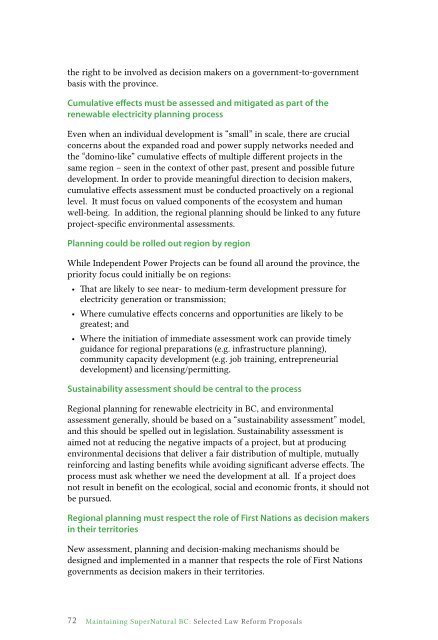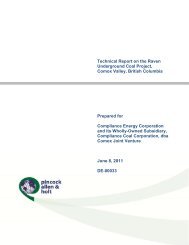Maintaining SuperNatural BC for Our Children - CoalWatch Comox ...
Maintaining SuperNatural BC for Our Children - CoalWatch Comox ...
Maintaining SuperNatural BC for Our Children - CoalWatch Comox ...
- No tags were found...
Create successful ePaper yourself
Turn your PDF publications into a flip-book with our unique Google optimized e-Paper software.
the right to be involved as decision makers on a government-to-governmentbasis with the province.Cumulative effects must be assessed and mitigated as part of therenewable electricity planning processEven when an individual development is “small” in scale, there are crucialconcerns about the expanded road and power supply networks needed andthe “domino-like” cumulative effects of multiple different projects in thesame region – seen in the context of other past, present and possible futuredevelopment. In order to provide meaningful direction to decision makers,cumulative effects assessment must be conducted proactively on a regionallevel. It must focus on valued components of the ecosystem and humanwell-being. In addition, the regional planning should be linked to any futureproject-specific environmental assessments.Planning could be rolled out region by regionWhile Independent Power Projects can be found all around the province, thepriority focus could initially be on regions:• That are likely to see near- to medium-term development pressure <strong>for</strong>electricity generation or transmission;• Where cumulative effects concerns and opportunities are likely to begreatest; and• Where the initiation of immediate assessment work can provide timelyguidance <strong>for</strong> regional preparations (e.g. infrastructure planning),community capacity development (e.g. job training, entrepreneurialdevelopment) and licensing/permitting.Sustainability assessment should be central to the processRegional planning <strong>for</strong> renewable electricity in <strong>BC</strong>, and environmentalassessment generally, should be based on a “sustainability assessment” model,and this should be spelled out in legislation. Sustainability assessment isaimed not at reducing the negative impacts of a project, but at producingenvironmental decisions that deliver a fair distribution of multiple, mutuallyrein<strong>for</strong>cing and lasting benefits while avoiding significant adverse effects. Theprocess must ask whether we need the development at all. If a project doesnot result in benefit on the ecological, social and economic fronts, it should notbe pursued.Regional planning must respect the role of First Nations as decision makersin their territoriesNew assessment, planning and decision-making mechanisms should bedesigned and implemented in a manner that respects the role of First Nationsgovernments as decision makers in their territories.72<strong>Maintaining</strong> <strong>SuperNatural</strong> <strong>BC</strong>: Selected Law Re<strong>for</strong>m Proposals



